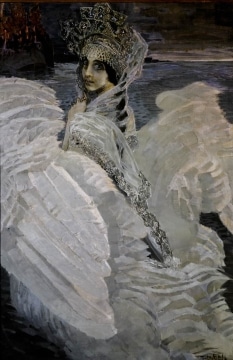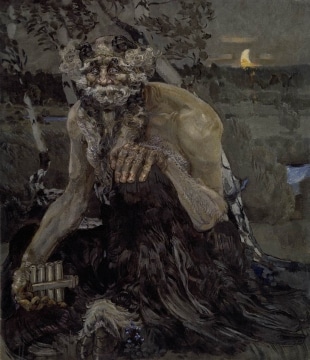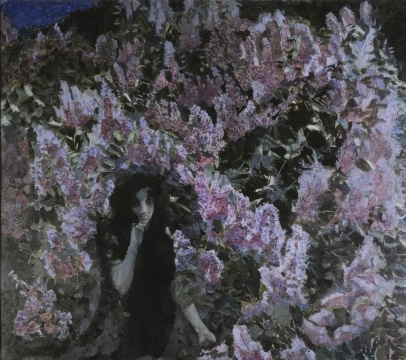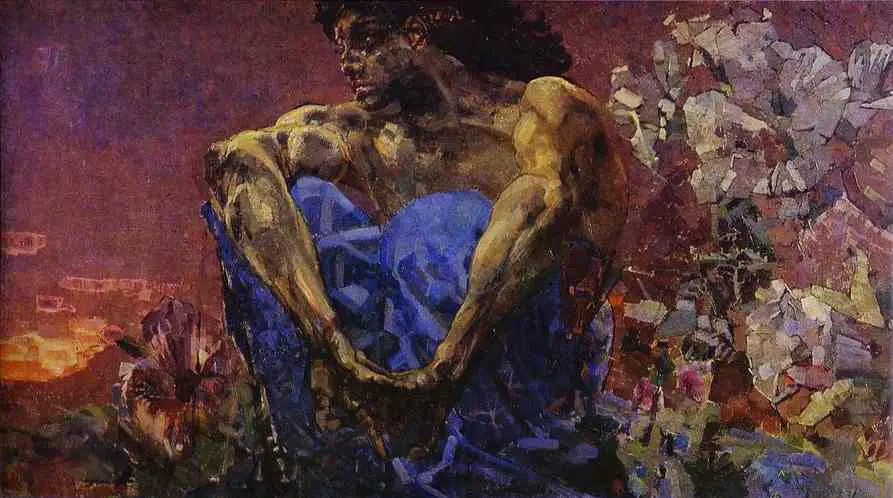
Mikhail Vrubel’s importance in Russian art is now undisputed, but during his own lifetime he achieved little success. He was heavily criticized for his rough, unrealistic forms, decorative use of space and strange motifs. He was a Symbolist and an expressionist at a time when most artists still ascribed to the Realist tradition of the Wanderers. The style he created was ornate and engrossing. It was both retrospective and shockingly innovative. Indeed, more than any other 19th century artist, he paved the way for the avant-garde which came after him.
Born in 1856, he began his artistic training in 1880 at the Petersburg Academy. After completing his studies, he was hired to do restoration work on the 12th century Church of Saint Cyril in Kiev. This was one of the most formative and cherished experiences of his life. The immersion in Byzantine art brought him a new vocabulary with which to express himself. Equally important was his involvement with Savva Mamontov’s Abramtsevo retreat. Here, a community of artists reexamined medieval Russian art, architecture, folklore and handcrafts. Vrubel found he could use the innately-felt Russian past to create a new and powerful means of artistic expression.
He also began wildly experimenting with the technical application of paint. In particular, he accented the early, rough stages of painting: those usually seen only before being smoothed into a more “Realistic” whole. Vrubel’s interest in Byzantine art also led him towards an interest in ornamentation.
He described the importance of ornamentation as follows:
“The chief mistake of the contemporary artists who try to revive the Byzantine style is their lack of appreciation for the Byzantine artists’ use of drapery. They make of it a mere sheet where they [the Byzantine artists] revealed so much wit. Byzantine painting differs fundamentally from three-dimensional art. Its whole essence lies in the ornamental arrangement of form which emphasizes the flatness of the wall” (qtd. in Gray 32).

He paired his own rough, mosaic-like style of painting with the rich ornamentation of the Byzantines in order to create a totally otherworldly experience – a transcendent, spiritual realm defined in opposition to our everyday reality.
And Vrubel usually chose subjects from other planes of existence. He habitually depicted scenes and characters from folklore and literature. Perhaps in creative realms he could more freely evoke the subtler states of human distress. He gave his figures markedly-large eyes. This was another technique learned from his study of Byzantine art. Figures with enormous eyes were meant to appear more spiritually-connected. They were both more aware and more vulnerable, altogether on a different plane than regular people. He also used the Byzantine palette of blue, purple, rose and pale green – a palette later to be taken up by the Symbolist painters of the Blue Rose.
Vrubel’s interest in medieval Russia led him to paint many folkloric characters. Vrubel’s Pan shows a friendly but powerful creature of the woods, evoking the leshiy forest spirit from Russian folklore more than the Greek god. By implying a union between nature and man (largely by intensifying the flat patterns of nature), Vrubel is better able to personify a natural scenario. In this case he shows the powerful awakening of nature at sunset. Pan appears to be in the process of emerging – he’s pressing his hand down on a stump, bleary-eyed as his powerful form comes into full view. The patterns of the leaves and grass interweave with his crouched form.
When Vrubel looked to literature for inspiration he usually sought to portray tragic situations or the dark sides of the figures themselves. He masterfully portrayed their complex, often dark emotional predicaments with symbolism and a sweeping mosaic of line. Among his masterpieces is a work depicting the doomed Princess from Swan Lake. She’s moving away into a darkening background, but she’s turning back to the viewer with Vrubel’s characteristic, large, all-knowing eyes. She, her swan-plumage and ornate dress all seem caught on the wind. They’re turning away unstoppably with the setting sun.

Another major part of Vrubel’s work was his Demon series, inspired by Mikhail Lermontov’s poem. Of course, the story is steeped in tragedy. The demon falls in love with a human woman named Tamara and he loses her. The figure of the demon himself is tragic: he’s more powerful than but utterly unlike those around him, and through his experiences he loses faith in humanity. Vrubel’s portraits of the Demon contain a feverish yet restrained energy. In the Demon Sitting, the viewer sees a tensed yet unmoving figure. Despite his power, he appears dejected, as if he’s given up on the ability to act. Vrubel described him as: “A spirit which unites in itself the males and female appearances, a spirit which is not so much evil as suffering and wounded, but withal a powerful and noble being” (qtd in Gray, 22).
This concept is another of Vrubel’s lifelong themes. When he painted Hamlet, he did so particularly in connection with the character Ophelia, sometimes intermixing the couple’s male and female characteristics. In one case, Ophelia is leaning over Hamlet’s chair. Her hands mimic the position of his, and their faces show many similarities. She leans forward against the chair, while he leans back. Essentially, they become part of the same figure, united in their many apprehensions.
Vrubel masterfully portrayed complexity in many female characters. He frequently painted gypsy women, the Rysalka from Russian folklore and the Madonna. He was heavily influenced, as were many contemporaneous artists, by mystic Vladimir Soloviev’s ideas about the divine Sophia – an envisioned, sacred female energy.
Vrubel at times endured poverty due to his lack of acceptance within mainstream art, though this was lessened by his association with Savva Mamontov. After his infant son died in 1902, he spent most of his time in and out of psychiatric clinics until he died in 1910. Many have connected this decline in mental health to his growing obsession with the demon figure. Indeed, the last painting in the demon series shows the demon cast down and destroyed. The figure is caught in an ornate pattern– as if swallowed by the flat surface of the piece itself.
Vrubel always felt obliged to create something new, yet this ‘new’ was forever entangled with wisdoms he’d unearthed from the past. His forward-backward-looking ideas and style placed him perpetually out of time and space, making his art a unique, timeless thing.







